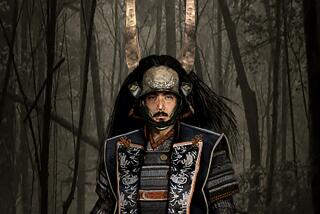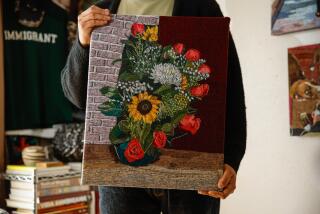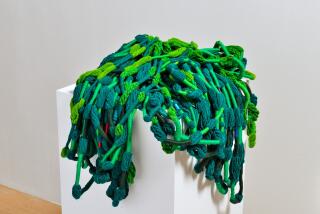China Silk Exhibit Reflects Country’s Rich Social Fabric : Art: Textile show at San Diego Museum of Art spotlights collection of fine garments.
SAN DIEGO — The Chinese, a 3rd-Century European monk wrote, “make precious figured garments, resembling in color the flowers of the field and rivaling in fineness the work of spiders.”
By the time of the Han dynasty (206 B.C.-220 A.D), richly dyed and embroidered Chinese silks had found their way to the West, about 2,000 years after the Chinese first began to cultivate the silkworm. The Chinese first became known to the western world as the Ceres, or Silk People, and for much of the country’s history, silk remained the primary language through which it communicated and traded with the outside world.
The splendor of Chinese silks peaked during the Ching dynasty (1644-1911), the period featured in the exhibition, “Dragon Robes of China’s Last Dynasty,” opening today at the San Diego Museum of Art, and continuing through Nov. 4. All 120 objects in the show--robes, headdresses, shoes and other accessories--belong to the museum’s permanent collection, and were assembled for this show by Sung, Yu, the museum’s curator of Asian art. She has studied and catalogued the collection since coming to the museum as an intern in 1981.
“Chinese women learned to do embroidery at the age of five,” Sung, Yu said during a recent tour of the museum’s storage vault, where last-minute conservation work was being done for the show.
“Any woman who could not do embroidery could not get married,” she said, a custom that held true until 1911, when China’s dynastic history ended and the country became a republic. Now, with the exception of amateur activity, hand-embroidered silks are produced only for export. Those for domestic use are made by machine.
The exquisite craftsmanship that created the rich detail of Ching dynasty textiles may be a lost art, but the silks themselves remain objects of living history. Within the delicate gold and silver stitching or the bold, boisterous patterns of Ching court robes are untold chapters of China’s social and political history. Enduring cultural values reside beneath the surface splendor.
The styles of the court robes tell of the ruling class’s character and history. When the Manchus invaded China from the north and installed themselves on the imperial throne in 1644, establishing the Ching dynasty, they altered the forms of traditional court dress to better reflect their own origins as a nomadic tribe.
“The Manchu emperors went hunting several times a year,” Sung, Yu said. “Their clothes were meant for action, tightly built,” in contrast to the looser cut of traditional Chinese robes. Slits on the bottom of the garments made it easier for members of the court to mount their horses, and an extended, “hoof-like” cuff protected their hands when riding or hunting in cold weather.
Despite these changes in the forms of the court garments, the images woven or embroidered into them remained consistent with those used for centuries. Central among these was the dragon as a symbol of the emperor.
“The founding emperor of the Han dynasty spread rumors that he was fathered by a dragon,” Sung, Yu explained, “so the dragon became a symbol of the royal family.”
One early Ching dynasty robe in the show features a large, sprawling creature that covers much of the garment’s back. Such designs were later abandoned, Sung, Yu said, because it was felt to be inauspicious to break up the pattern with a belt. In later Ching-period robes, the dragon appears in smaller roundels that don’t cross the waistline.
One such robe, a spectacular creation of coral silk, bears a broad embroidered hem, dense with patterns of waves, clouds and images from Chinese folklore. The dragon, both feared and revered, “can cause rain, and can make everything grow,” Sung, Yu said, thus the clouds embroidered here are a good omen, promising fertility and abundance. Among the other symbols present are a pair of coins, signifying wealth, and the cosmic emblems of the four directions.
“There is also a fifth direction, the center,” Sung, Yu said. “It is the most important and is guarded by the emperor.” On the robe, it is represented by the emperor’s head emerging from the neckline.
Symbols, patterns and styles of clothing became legible indicators of status within the Ching dynasty court. A single peacock feather in one’s headdress tassel, for instance, signified membership in the lowest rank of the court, while members of the royal family were identified by three feathers.
An embroidered, decorative panel in the exhibition shows that such symbols could be used equally well with irreverent intent. In the late 19th Century, Sung, Yu explained, the Empress Dowager Tze-hsi indicated her own esteemed status by reversing the position of the phoenix, symbol of the empress, with that of the dragon, symbol of the emperor. In the panel commissioned by Tze-hsi, the phoenix appears higher in the sky than the dragon, indicating a switch in the relative power of the emperor and empress. “No other empress dared to do this,” Sung, Yu said.
Together, the dragon robes and such accessories as snuff bottles, compact survival kits to be worn at the belt, thick stone rings to protect an archers’ thumbs and elaborate fingernail ornaments that implicitly acknowledge the wearer’s use of servants all help form a richly textured picture of life in the Ching dynasty court.
When the last emperor left the palace in the early 1920s, the market for Ching dynasty textiles and other objects surged. In 1926, in keeping with an international trend, the San Diego Museum of Art (then the Fine Arts Gallery) began collecting the dragon robes that form the centerpiece of this exhibition. Though the collection now includes more than 150 textiles, “Dragon Robes” marks the museum’s first attempt to highlight its Ching holdings.
Sung, Yu attributes this lack of attention to the overall lack of understanding many Americans have of Chinese art.
But, she adds, the Chinese themselves “have to be trained to appreciate it.”
More to Read
The biggest entertainment stories
Get our big stories about Hollywood, film, television, music, arts, culture and more right in your inbox as soon as they publish.
You may occasionally receive promotional content from the Los Angeles Times.










